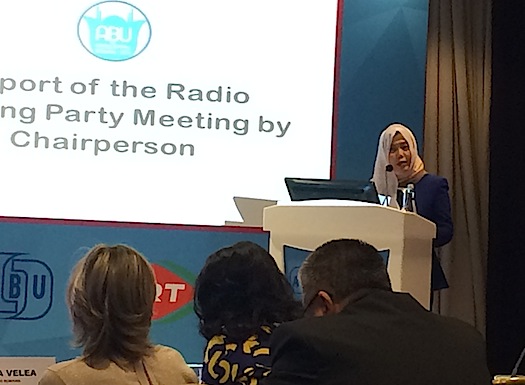“Radio is a very stubborn medium – it refuses to go away,”
said MediaCorp’s Zakiah Halim (pictured) in Istanbul, at the Asia Pacific Broadcasting Union’s general assembly.
In the Radio Working Party session, TRT’s Director of Radio Ankara, Murat Orem, talked about the global village, making the point that when villages grow they become towns, and in towns there are often problems, which include isolation.
Radio can help solve problems as villages become more global, because it is close to the people. He said one of the goals of TRT Radio 1 is to entertain and educate, using ‘edutainment’ principles.
Shanthi Bhagirathan from MBC Sri Lanka gave examples from Sri Lanka of how radio is being used to help the community in areas such as: emergencies, anti-drugs campaigns, national unity activities and religious programs. She said these programs have their origins in supporting the people, but are also resulting in better engagement with audiences and improvements in ratings and revenue. A public-private partnership initiated by MBC Networks to assist after disasters has now been recognised by the UN and is being used as a model for other countries.
Kabul Budiono, the Director of Programming and Production at Radio Republik Indonesia said “good programming must be based on good research.” But it should not just be research that is focused to advertisers, it must be research that is focused to the people and it must find out what they need from broadcasters. As a national broadcaster, RRI seeks to serve the needs of the people first, and then the needs of the advertisers, which is in contrast to commercial media, who must serve the needs of advertisers first.
Fraunhofer’s Alex Zinc urged delegates to remember the extra benefits that digital radio brings, especially in the areas of emergency messaging and getting close to young people. “Radio has a unique set of elements to reach people in emergencies,” he said, demonstrating how digital radios can turn themselves on and broadcast emergency warnings in times of crisis.
In a debate session about the future of radio, moderator Beyond Broadcasting’s Ben Williams, said broadcasters should plan how they will use social media before a program is made, and integrate it into the program lead up, use it during the show and also after the show has been broadcast.
Zakiah Halim urged broadcasters to “look for opportunities to share your content across many platforms.”
Au Lai Ngar from RTHK showed how her station is using apps to great advantage to connect with audiences who are increasingly using mobile phones as their receiving platforms. “Use apps to draw people back to your radio programs,” she said.
Kartini Ariffin from youth station IM4U Malaysia said young people want information and entertainment just like everyone else, but they use new platforms to find it, so broadcasters must be on these new platforms to reach youth.
“The audience demands more of us now,” said Cem Temel Director of Radio Istanbul, who said radio has moved beyond just sound, so broadcasters should experiment with social media and new developments such as Periscope. TRT is broadcasting about 10 mins of some programs simultaneously on social media as well as on radio.
IMBA CEO Steve Ahern said smartphones have made radio mobile again. “Radio can get back in people’s pockets if it is in these new devices. So make sure you have a mobile strategy,” he told delegates.
“With new technology such as smartphones and social media interaction, it would be easy to forget the fundamentals of radio,” said Ahern.
“So remember that on radio the pictures are better, because they are personal pictures in your own head, not a photo or video that someone has made for you. Radio is still a powerful personal medium – your friends are there with you, they curate your playlists and share their engagement with what is going on in your local community and in the world.
“Radio is still a powerful personal medium if we use it to its best advantage…. You may need to restructure how you do things, but the power of audio creative programming is still relevant on new platforms,” he said.
As an example of the changes taking place in response to new media platforms and audience habits, Zakiah told the audience that Media Corp is no longer structured along transmission lines such as radio and tv, it is structured by audience output.

